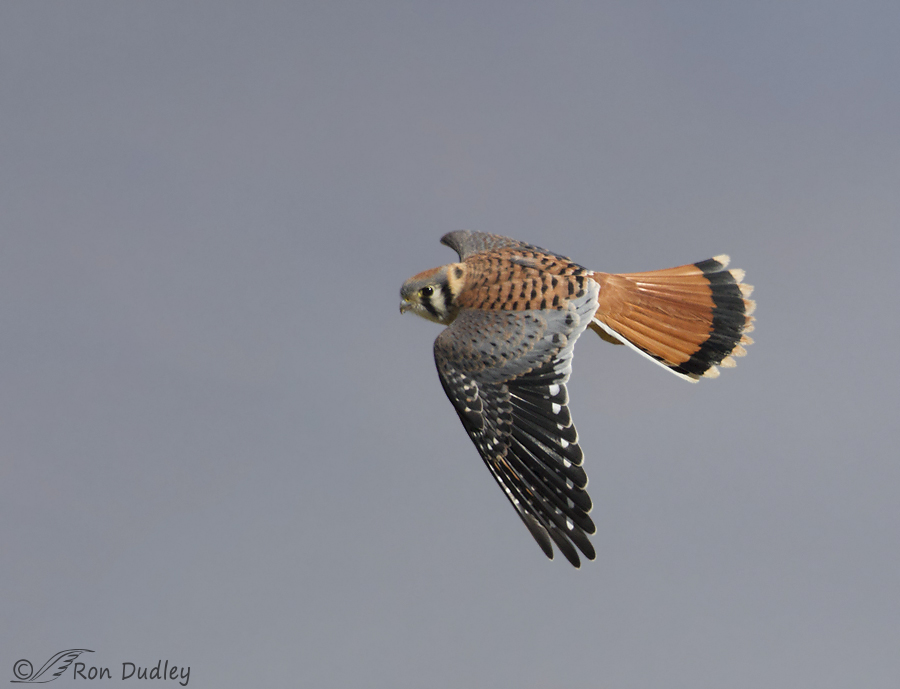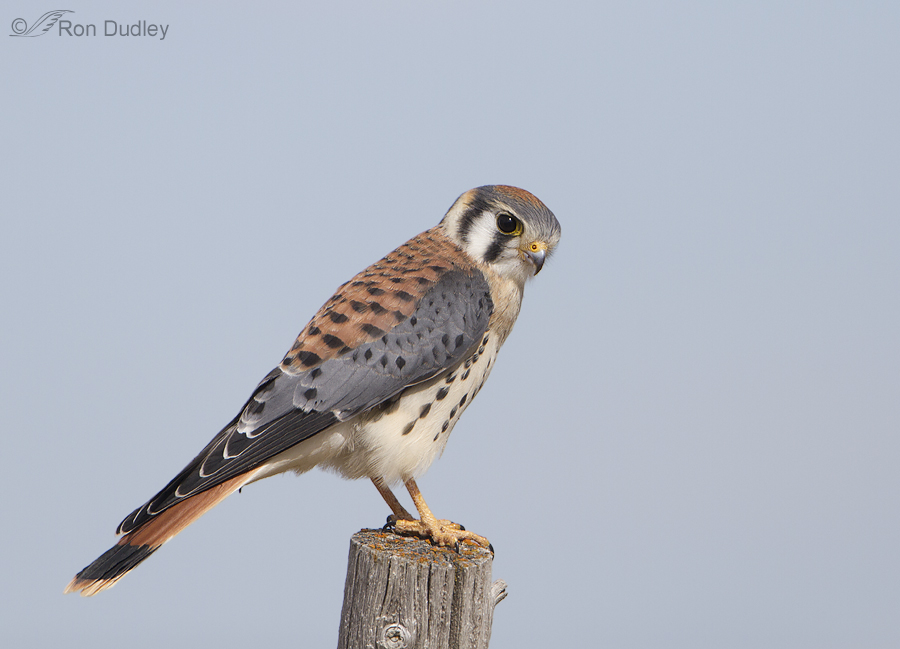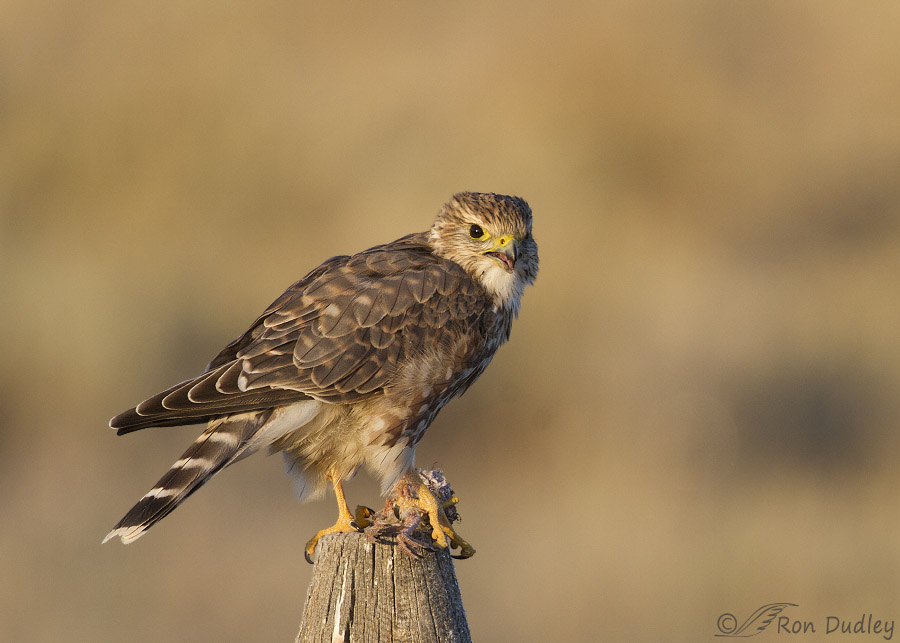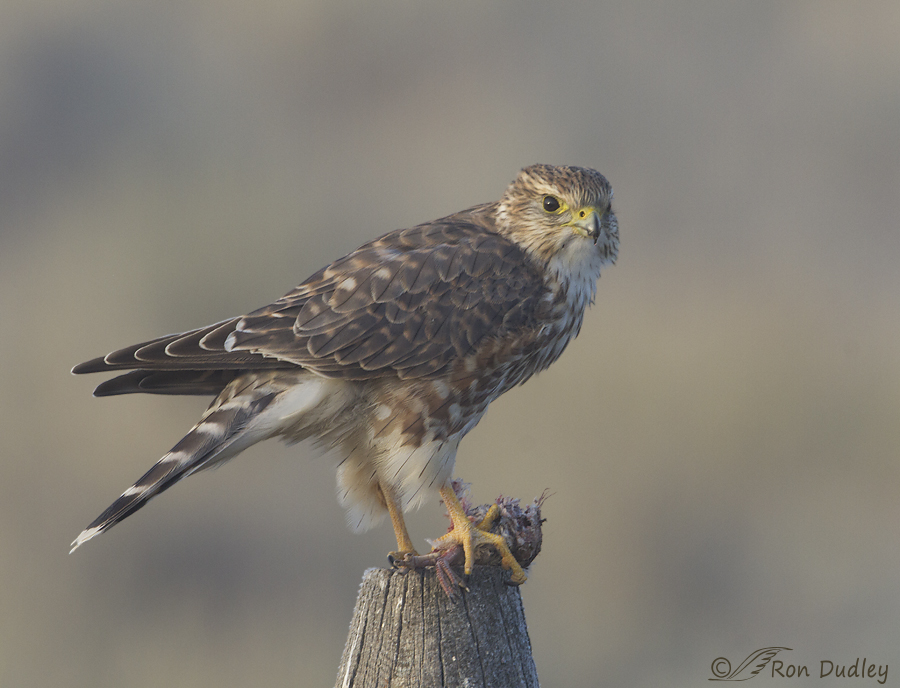Tag: falcon
Montana Merlin In The Fog
Southwest Montana Kestrels – A Status Update

American Kestrels have long been North America’s most abundant bird of prey but over recent decades their numbers have declined precipitously. For that reason I pay particular notice to kestrel numbers when I return to the same area year after year and because I spend so much time in southwest Montana that region is near the top of my “kestrel watching” areas.
Some Good News On The Kestrel Front

Several weeks ago I reported here about the alarming decline of the American Kestrel in most of North America. That decline has been apparent to me locally (Utah) as I’m seeing and photographing far fewer of them than in the past. Other more scientific and reliable sources report similar declines in many areas of the continent.
But apparently there are pockets of habitat where kestrels are still thriving and one of them is the Centennial Valley of southwest Montana.
A Plucky Female American Kestrel Saves My Day
Sometimes a single bird saves the day for the bird photographer. That was exactly the case last Wednesday.
American Kestrels In Snow, Frost And Fog
Photographing American Kestrels near the Great Salt Lake during the coldest parts of winter is a two-edged sword. On the one hand the frigid temperatures in December and January make the kestrels “stickier” – much less likely to fly off before you can get close enough for quality photos. But there’s a down side too. Moisture from the lake often forms fog or at least makes the air so incredibly laden with moisture that good lighting often becomes an issue. I’ll still take the shot under some of those conditions though – a close-up with the bird large enough to very nearly fill the frame is still usually much more desirable than a well-lit bird so small in the frame that little detail can be seen. 2000, f/7.1, ISO 400, 500 f/4, 1.4 tc In this image the background is snow and there had been a blizzard the day before which had stacked snow up on one side of the perch. This was one of the first times I’d ever been close enough to a kestrel to get a frame-filling image and I well remember having a case of “buck fever” while photographing him at such close range. Also a bit unusual was the fact that I was actually looking slightly down at him – something that doesn’t happen often with kestrels. 1600, f/7.1, ISO 500, 500 f/4, 1.4 tc This shot illustrates well what you get when the atmosphere is so laden with moisture when it’s very cold – fog, low but even light, some reduction in detail and sometimes…
Just A Shot That I Like… #14 – Prairie Falcon Warming In The Early Morning Sun
As I’ve mentioned previously in this blog Prairie Falcons have been one of my nemesis birds for a very long time. But recently I had several close up opportunities with the species. 1/3200, f/6.3, ISO 500, 500 f/4, 1.4 tc This juvenile falcon had been hunting smaller duck species along the shore of the Great Salt Lake and would occasionally rest on some shoreline rocks. This time I caught it enjoying the warming rays of the sun just minutes after sunrise. Here the warm light has just reached the bird and perch but hadn’t yet hit much of the water in the background. I’ve posted several images of this species recently and perhaps I’ve overdone it but I guess my excitement over finally “conquering” a nemesis just got the best of me… Ron Addendum: A note to any bird photographers who may notice my camera settings for this image and wonder about them. I certainly didn’t need 1/3200 shutter speed for this static image but I had already taken multiple shots of this falcon with more appropriate settings for a perched bird so now that I had enough light I decided to increase my shutter speed in preparation for take-off. But of course the bird took off facing away from me so I deleted those images.
American Kestrel Preening on a Rabbitbrush Perch
American Kestrels are pugnacious and skittish little falcons that are usually difficult to approach. But last week I found a cooperative male warming himself in the early morning sun while perched on rabbitbrush. Though feisty by nature this kestrel looked almost cuddly while all puffed up against the cold and nestled into the bush. 1/2000, f/8, ISO 500, 500 f/4, 1.4 tc I first approached him head-on which gave me some images where bird and perch combined to produce a pyramid shape that I liked. 1/3200, f/6.3, ISO 400, 500 f/4, 1.4 tc But then I maneuvered to get a different angle so that at least part of the tail would be visible. In these early shots my camera settings were meant to give me enough shutter speed for the take-off that I fully expected. 1/2000, f/7.1, ISO 250, 500 f/4 But when he began to groom contentedly I started fiddling with my settings to get shutter speeds and depth of field more appropriate for the situation. Here he is passing one of his tail feathers through his bill in typical preening behavior. 1/1600, f/8, ISO 250, 500 f/4 He gave me a variety of preening poses that I liked. 1/1250, f/8, ISO 250, 500 f/4 Some of the neck feathers are difficult to reach so they go through some strange contortions in an effort to get to them. 1/1600, f/8, ISO 320, 500 f/4 Here the eye was half closed but I was still able to get a catch light. …
Peregrine Falcon Feeding Behavior (graphic)
The Peregrine Falcon has always been a nemesis bird for me. I’ve occasionally seen them far off, either in flight or perched, but have never been able to get close to one. All that changed last week when I spent an incredible half hour very close to a young bird while it was feeding on a female Northern Shoveler. That’s the good news. The bad news is that there was no LIGHT! DAMMITALL! It was heavily overcast with only a bright spot in the clouds to mark the position of the sun. As usual, this kind of situation requires lots of compromises between shutter speed, ISO, depth of field, motion blur, catch lights, ad infinitum… So compromise I did but I still got many feeding behavior images I find interesting. And since one of the primary focuses of this blog is bird behaviors, you guessed it – a blog post… First – a warning. Some of these photos are graphic. Proceed with caution if your sensitivities are fragile. 1/250, f/5.6, ISO 640, 500 f/4, 1.4 tc As I first approached this falcon it was depluming the duck. At times feathers were flying everywhere but at these shutter speeds and apertures many of those shots ended up in the delete bin. At this point I was still using the 1.4 teleconverter but the bird soon let me approach close enough that I was able to ditch the tc and get slightly more shutter speed. Take visual note of the size of the crop in this image when the falcon has just begun…
Just A Shot That I Like… #8 – Prairie Falcon In Warm Light
I’ve tried and failed for a long time to catch a raptor perched on the darker rocks (Farmington Canyon Complex) that are most common on the southern part of Antelope Island. I think these rocks make much more attractive perches than the almost white and difficult to properly expose Tintic Quartzite boulders on the north portion of the island. Last week I finally succeeded with this Prairie Falcon. 1/1000, f/7.1, ISO 640, 500 f/4, 1.4 tc As an added bonus the sun was just coming up over the Wasatch Mountains so the golden light added some warmth to the image which I like. I only got off a handful of shots but at least the bird turned its head into the light before it flew off. Based on bill color I believe it to be a first year bird. Now if I could only get this close to a Peregrine Falcon in good light… Ron
Lamenting the Loss of a Favorite Perch
This was a perch I had a love-hate relationship with for almost four years. It was a small, very old and sun-bleached snag along the road down unit 1 at Farmington Bay Wildlife Management Area. I loved it because American Kestrels liked to use it as a hunting perch, it was close to the road, not too high and it was natural and photogenic. I hated it because it was on the east side of the road (I could only shoot from the road in my vehicle – open the door and the kestrel skedaddles) which meant that I was usually shooting into the sun in the morning which is my favorite time to photograph birds. Back-lit kestrels are generally not a pretty sight… That road down unit 1 is closed for the nesting season (March through September) and I was very disappointed to see on my first trip down the road this fall that the snag was gone. It may have fallen down on its own, been removed by refuge managers (which I doubt) or perhaps it was vandalized – I just don’t know. But I will miss it, as will the kestrels I’m sure. Avian photographers on this continent are well aware of how difficult this species is to get close to – they’re very skittish and almost never allow a close approach for photography. That changes in mid-winter when it’s very cold. They simply are much more reluctant to fly when it’s that frigid and the photographer can occasionally get quite close to them, especially when shooting from a vehicle. But most nature photographers…
Prairie Falcon – A Nemesis Resolved
Every avian photographer has their “nemesis birds” – a species or two that the gods of photography have foiled any and every attempt at getting quality images of. For me the Prairie Falcon has been at or near the top of that list. I particularly love to photograph raptors but locating and then getting close to this falcon in good light has eluded me for five years now. But two days ago I resolved that dilemma! 1/4000, f/5.6, ISO 640, 1.4 tc We first spotted this bird coming towards us along the Antelope Island causeway just as the sun peeked over the Wasatch. It soon landed on this stump and in good light but I wasn’t quite as close to the bird as I’d like to have been. Soon it lifted off and hunted the causeway going west, causing quite a ruckus among the gulls, shorebirds and ducks as it approached them. It was fairly easy to track the falcon by watching for groups of panicked birds taking to the air. 1/1000, f/5.6, ISO 800, 1.4 tc Next it landed on this interesting rock and I was able to get a little closer. The background is a little funky with the harsh color transition between water and rocky shoreline passing through the bird but I liked the perch and the good look at the entire bird, including tail. I suspect that this falcon has learned the fine art of thievery. Earlier this week we observed a Prairie Falcon along the causeway chase off a Peregrine Falcon from its Ruddy Duck…
American Kestrel, Preening and Stretching
This slightly wet and bedraggled (but still handsome) male kestrel was quite wary of me as I approached him on his favorite perch. 1/1250, f/5.6, ISO 500, EV +0.67 American Kestrels are notoriously difficult to get close to and several times he nearly flew off as I slowly worked myself within good shooting distance. But it had been a cold morning and these birds are more “sticky” in the chill so he allowed me a relatively close approach. 1/1000, f/7.1, ISO 640, EV +0.33 Soon after he became comfortable in my presence the warming sun came out (as you can tell by the difference in background in the first two images) and he began to preen. I got many interesting images of him working on his tail feathers but this one shows the eye best. For protection of their eyes they typically close them as they run a feather through their beak. 1/1000, f/8, ISO 640, EV +0.33 And then he began a long, slow stretch – first by fanning his tail… 1/1000, f/8, ISO 640, EV +0.33 and then stretching out his left wing downward. As you can see, they often stretch all three “limbs” at the same time – tail, wing and leg. 1/1000, f/8, ISO 640, EV +0.33 When it was over he fluffed up his feathers and held this position, with one foot up, for quite a while to enjoy the warmth of the sun. I have many photos of perched kestrels but I don’t often get…
American Kestrels – What They’ll Eat and What They Won’t.
I’ve always found it fascinating to watch these little falcons eat. A gruesome experience to be sure but so much more interesting than observing a raptor such as an owl who simply swallows its prey whole. And if you watch carefully there’s a whole lot more going on during the process than first meets the eye. Kestrels can be pretty picky eaters. I’ve documented in another post on this blog that they often refuse to eat the intestinal tract of their prey and deliberately discard it. Kestrels, like other raptors, eject pellets of indigestible materials like fur, feathers, chitin and bone. All food that is swallowed first goes to the crop. From there the usable food continues on to the stomach but the indigestibles stay in the crop, are formed into a pellet and regurgitated roughly 23 hours (in the case of kestrels) after the meal was consumed. Canon 7D, 1/800, f/7.1, ISO 640, 500mm f/4, 1.4 tc The kestrels I’ve watched eating voles and mice typically eat the brain, decapitate the rodent, then go for the soft internal protein rich muscles and other organs (discarding the intestines). Since kestrels tear their prey into bite-sized pieces they can pick and choose what they actually swallow. Canon 7D, 1/400, f/8, ISO 640, 500mm f/4, 1.4 tc Pellet expulsion can be difficult and traumatic as I’ve documented elsewhere on this blog with Northern Harriers and I suspect that’s one of the reasons that kestrels try to avoid swallowing as much fur as possible. When opening up the body cavity they often get a beak-full of…
American Kestrel – The Killing Bite
I have watched American Kestrels consume their prey up close many times. Usually that prey has been a vole but occasionally it’s been a small bird or mouse. But until this day the prey had always been already dead when I arrived on the scene. It was cold and snowy when I spotted this male kestrel with a mouse (I was surprised it wasn’t a vole) that was still very much alive. As a side note I want to add here that this kestrel was not baited. Many photographs are taken of raptors when they’ve been baited by mice (they can be bought at pet stores) that have been provided as an enticement by the photographer. That was not the case here – I do not bait. Male kestrel with live mouse It was obvious that the mouse was alive because it was struggling slightly, its tail was twitching and its eyes were open. In my experience these birds often prefer a more stable perch than this while they eat their meal – something like a fencepost or pole that provides some kind of platform from which to eat. So I didn’t think he would eat the mouse here and I was right. He gave me time for a few quick shots and then flew off to another perch. Kestrel on second perch He didn’t go far however and I was able to approach him again. This next perch was also precarious to eat from because the wind was blowing and both perch and bird were swaying in the breeze. …



